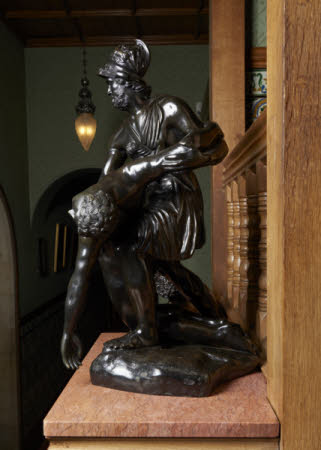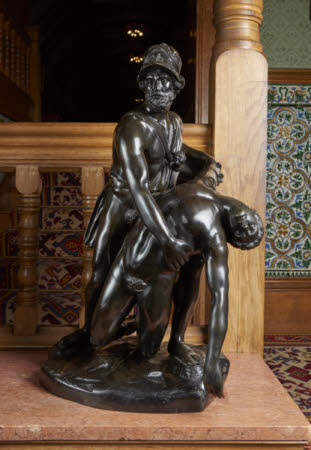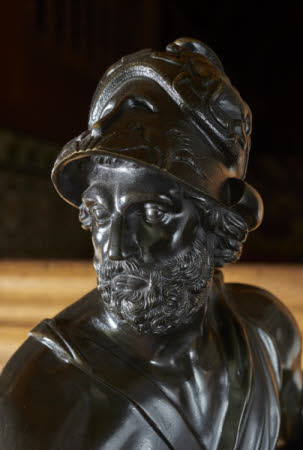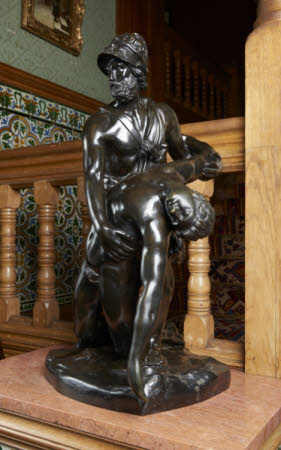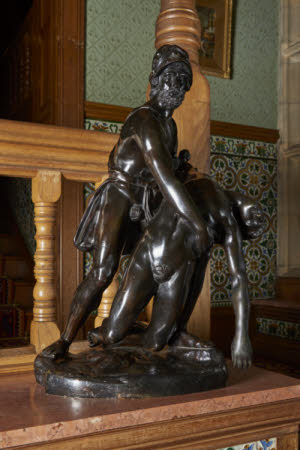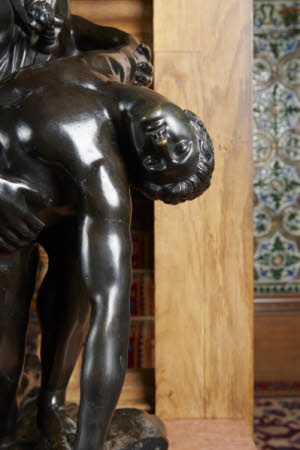Menelaos and Patroclus ('Pasquino')
Category
Art / Sculpture
Date
c. 1850 - 1900
Materials
Bronze
Measurements
775 mm (H)
Place of origin
Florence
Order this imageCollection
Cragside, Northumberland
NT 1228374
Summary
Bronze; the Pasquino, or Menelaos with the body of Patroclus, after an antique model; Italian, c. 1850-1900. A bronze reduction of a restored antique statue in the Loggia dei Lanzi in Florence, traditionally known as the Pasquino after another fragmentary version, but representing the Greek warrior Menelaos, husband of Helen of Troy, holding the body of Patroclus after he had been slain by the Trojan prince Hector.
Full description
A bronze statuette known popularly as the Pasquino, depicting a scene from the Trojan war, with king Menelaos holding the body of Patroclus after he had been killed by Hector. Menelaos is naked except for a short tunic; at his side he wears a sword and on his head a helmet decorated on the sides with scenes of combat between lapiths (a mythical people living in Thessaly in Greece) and centaurs. He holds up the slumped naked body of the dead Patroclus, using his left thigh as a support for it. Both figures are equipped with crudely modelled fig-leaves. On an integral bronze base with a rough surface. The bronze depicts a scene from Homer’s Iliad, in which the story of the Trojan war is told. The Greek Patroclus, friend of the hero Achilles, donned his friend's armour and drove the Trojans back to their walls, but he was then wounded and his armour stripped from him, leaving him naked. As he tried to creep away, Patroclus was spotted by Hector who killed him. Menelaos, king of Lacedaemon and husband of Helen of Troy, whose abduction was the cause of the war, saw Patroclus fall and came and stood over the body, protecting it from the Trojans, so that it could be carried away for burial. It was the death of Patroclus that persuaded Achilles he should return to the war, spelling the death of Hector and the eventual downfall of Troy. A reduction after an antique statue known in three principal versions (Francis Haskell and Nicholas Penny, Taste and the Antique. The Lure of Classical Sculpture 1500-1900, New Haven/London 1981, pp. 291-96, no. 72). They are traditionally known as Pasquino, after the best-known of these figures, a fragmentary Hellenistic version that has, since at least 1500, stood in Piazza Pasquino in Rome, near the Piazza Navona. It is said to have originally been named Pasquino, because it was found near to the house of a schoolmaster of that name. Over the centuries, the statue in Rome became famous as increasing numbers of anonymous scurrilous notices known as pasquinades, many of them fiercely anti-Papal, were attached to it. The more complete version of the statue now in Florence in the Loggia dei Lanzi was found around 1570 and quickly brought to Florence, where it was restored in the seventeenth century on the basis of a model made by Pietro Tacca. A third version came to Florence around the same time, was restored in 1830 by Stefano Ricci, and is today in the Palazzo Pitti. The bronze is a reduction of the statue in the Loggia dei Lanzi, and was probably made in a Florentine foundry during the second half of the nineteenth-century. It follows the original statue reasonably closely, but is not a very sophisticated copy. The fig-leaves, additions not found on the sculpture in Florence, reflect Victorian sensibilities. Jeremy Warren March 2022
Provenance
Armstrong collection. Transferred by the Treasury to The National Trust in 1977 via the National Land Fund, aided by 3rd Baron Armstrong of Bamburgh and Cragside (1919 - 1987).
